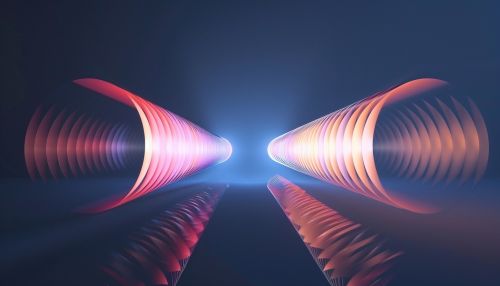Babinet's principle: Difference between revisions
(Created page with "== Introduction == <div class='only_on_desktop image-preview'><div class='image-preview-loader'></div></div><div class='only_on_mobile image-preview'><div class='image-preview-loader'></div></div> Babinet's principle is a fundamental concept in the field of wave optics, named after the French physicist Jacques Babinet. This principle states that the diffraction pattern produced by an opaque object is identical to the diffraction pattern produced by a hole of the sa...") |
No edit summary |
||
| Line 1: | Line 1: | ||
== Introduction == | == Introduction == | ||
[[Image:Detail-91353.jpg|thumb|center|Illustration of Babinet's principle with two complementary diffraction patterns.|class=only_on_mobile]] | |||
[[Image:Detail-91354.jpg|thumb|center|Illustration of Babinet's principle with two complementary diffraction patterns.|class=only_on_desktop]] | |||
Babinet's principle is a fundamental concept in the field of [[wave optics]], named after the French physicist Jacques Babinet. This principle states that the diffraction pattern produced by an opaque object is identical to the diffraction pattern produced by a hole of the same shape and size, except for the forward direction where the intensity is the sum of the two patterns. Babinet's principle is particularly useful in the analysis of diffraction and interference patterns and has applications in various areas of physics and engineering. | Babinet's principle is a fundamental concept in the field of [[wave optics]], named after the French physicist Jacques Babinet. This principle states that the diffraction pattern produced by an opaque object is identical to the diffraction pattern produced by a hole of the same shape and size, except for the forward direction where the intensity is the sum of the two patterns. Babinet's principle is particularly useful in the analysis of diffraction and interference patterns and has applications in various areas of physics and engineering. | ||
Latest revision as of 16:01, 21 June 2024
Introduction


Babinet's principle is a fundamental concept in the field of wave optics, named after the French physicist Jacques Babinet. This principle states that the diffraction pattern produced by an opaque object is identical to the diffraction pattern produced by a hole of the same shape and size, except for the forward direction where the intensity is the sum of the two patterns. Babinet's principle is particularly useful in the analysis of diffraction and interference patterns and has applications in various areas of physics and engineering.
Historical Background
Jacques Babinet formulated this principle in the early 19th century, contributing significantly to the understanding of wave phenomena. His work built upon the earlier studies of Thomas Young and Augustin-Jean Fresnel, who had laid the groundwork for the wave theory of light. Babinet's principle provided a new perspective on diffraction, emphasizing the complementary nature of objects and apertures.
Theoretical Foundation
Wave-Particle Duality
Babinet's principle is rooted in the wave nature of light. According to the principle, the diffraction pattern of an opaque object and its complementary aperture are identical because they both disturb the wavefront of light in a similar manner. This concept aligns with the Huygens-Fresnel principle, which states that every point on a wavefront acts as a source of secondary spherical wavelets.
Mathematical Formulation
Mathematically, Babinet's principle can be expressed using the superposition principle. If \( U_1 \) is the wave disturbance due to an opaque object and \( U_2 \) is the wave disturbance due to the complementary aperture, then the total disturbance \( U \) in the forward direction is given by:
\[ U = U_1 + U_2 \]
In regions other than the forward direction, the disturbances \( U_1 \) and \( U_2 \) cancel each other out, leading to identical diffraction patterns.
Applications
Optical Engineering
Babinet's principle is extensively used in optical engineering, particularly in the design of diffraction gratings and aperture synthesis techniques. By understanding the diffraction patterns of complementary structures, engineers can optimize the performance of optical devices.
Radio Wave Propagation
In the field of radio wave propagation, Babinet's principle helps in the analysis of antenna radiation patterns. The principle is used to predict the behavior of electromagnetic waves when they encounter obstacles, aiding in the design of efficient communication systems.
X-ray Crystallography
Babinet's principle also finds applications in X-ray crystallography, where it assists in interpreting the diffraction patterns of crystals. By analyzing the complementary diffraction patterns, scientists can deduce the atomic structure of materials.
Experimental Verification
Numerous experiments have verified Babinet's principle. One classic experiment involves using a circular disk and a circular aperture of the same size. When monochromatic light passes through these objects, the resulting diffraction patterns are observed to be identical, confirming the principle's validity.
Limitations and Extensions
While Babinet's principle is highly useful, it has limitations. The principle assumes ideal conditions, such as perfect coherence and monochromatic light. In real-world scenarios, factors like partial coherence and polychromatic light can affect the diffraction patterns. Extensions of Babinet's principle have been developed to account for these factors, enhancing its applicability.
See Also
- Diffraction
- Interference (wave propagation)
- Huygens-Fresnel principle
- Thomas Young
- Augustin-Jean Fresnel
- Aperture synthesis
- X-ray crystallography
